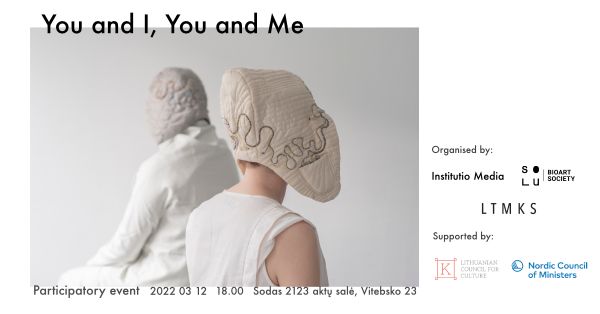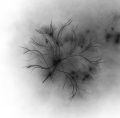You and I, You and Me
Contents
Tutorial: You and I, You and Me
With Mindaugas Gapševičius and Maria Safronova Wahlström
The You and I, You and Me tutorial proposes to explore the possibilities of communication through electricity. Here Mindaugas Gapševičius and Maria Safronova Wahlström propose that electricity could help to reveal the imperceptible connections between different actors within the environment. How far could electricity help in understanding the other? Is there a possibility to alter human senses by electric impulses?
Workshop
Institutio Media invites you to take part in the workshop on collaborative experience around brain-to-brain interfaces. Travel and accommodation for participants from the Nordic-Baltic countries are covered by the organizers. For inquiries and registration please send an email to o-o@o-o.lt. The deadline for applications is February 23, 2022.
Workshop: @Alt lab & online, Institutio Media, Vilnius With artists Mindaugas Gapševičius and Maria Safronova Wahlström And neuroscientists Ian Erik Stewart, Amelia Young and Cristiàn Ruiz de la Era 10-12 March 2022
Mindaugas Gapševičius and Maria Safronova Wahlström will hold a three-days workshop on making headwear as part of You and I, You and Me project. The headwear will embed electronic circuits that use electricity as a possible form of communication between humans. The workshop will end up as a participatory event with the audience, who will be invited to speculate on possibilities of communication through electricity.
The project You and I, You and Me explores the possibilities of communication through electricity. The project proposes that electricity could help to reveal the imperceptible connections between different actors within the environment. How far could electricity help in understanding the other? Is there a possibility to alter human senses by electric impulses?
Mindaugas Gapševičius (LT/DE) explores the impact of non-human actors on human creativity and the impact of humans on the umwelt. Maria Safronova Wahlström (RU/SE) is interested in social myths, and works with themes such as collective behaviour and linguistic practices that signal our social belonging. Ian Erik Stewart (DE) is a driven Neuroscience Researcher and passionate Science Communicator. Amelia Young (DE) is a neuroscience researcher seeking to connect to the larger community through art and neuroscience. Cristiàn Ruiz de la Era’s (ES/LT) research is focused on Clinical Neuroscience, Cognitive Science, and Biological Psychiatry.
More information about the project: http://triple-double-u.com/headwear/ Alt lab: http://www.o-o.lt/alt-lab/
Program
Preliminary program @ Alt lab (hands on) & online (public events)
10 March 2022
11:00-13:00 textiles & brain-to-brain interfaces. Maria Safronova & Mindaugas Gapševičius 13:00-18:00 hands on workshop 18:00-20:00 positions on brain. Ian Erik Stewart, Amelia Young & Felix Töpfer, and Cristiàn Ruiz de la Era
11 March 2022
11:00-20:00 hands on workshop
12 March 2022
11:00-18:00 hands on workshop 18:00-20:00 participatory event
Presentations
Cristian M. Ruiz de Lara, is a translational researcher in the field of clinical neuroscience. With a background in medicine, psychology, and neuroscience, he is interested in how the brain supports emotions and self-related processes, with particular relevance to mental disorders. Combining decision-making theories with neuroscience techniques for a better understanding of brain dysfunctions in psychiatric disorders, especially addictions. Applying neuroimaging and electrophysiology techniques to disentangle interactions between the brain, cognitive functions, and behavior.
Ian Erik Stewart is a neurobiologist and electrophysiologist who studies the electrical activity of the brain related to cognitive and sensory processes in humans and animals. He asks what the electrical signals of populations of neurons can tell us about how we consciously perceive the world and our own selves – what is the bandwidth of consciousness? How well can we see and feel what is actually happening to us and around us? In previous work with EEG, he investigated the attentional limits of visual tracking, and discovered evidence for a reflexive change of attentional focus depending on our perceptive intention.
Felix Töpfer and Amelia Young will research fNIRS (functional near-infrared spectroscopy). fNIRS detects changes in brain blood oxygenation (and therefore activation) by picking up differences in how much light is absorbed and reflected back to optical detectors. What makes fNIRS advantageous is its portability, real-time capabilities, and potential for long-term monitoring. Felix Töpfer and Amy Young from NIRx will be sharing about the technology and applications. NIRx has been combining hardware and software into research solutions for near-infrared spectroscopy (NIRS) for 21 years.
Participatory event
Creative workshops and participatory events organized in non-disciplinary research laboratory and community space Alt lab, located in SODAS 2123 cultural complex, invites you to explore and rethink our relationships with one another, nature’s creative potential and ecological, social, ethical or philosophical issues related with that.
Participatory event “You and I, You and Me”, taking place on the 12th of March, 6 p.m., will invite to raise questions about the potential of electricity as a means of communication. Is it possible to change one’s senses with electrical impulses? How can electricity help communication and influence our relationship with the environment?
This event is the result of a three-day creative workshop “You and I, You and Me”. During the workshop, which will take place on March 10-12, Mindaugas Gapševičius and Maria Safronova Wahlström, together with the participants, will create headgear that uses electricity as a tool for non-verbal communication through newly generated sensations. The guests of the creative workshop, neuroscientists Ian Erik Stewart, Cristiàn Ruiz de la Era, Amelia Young and Felix Töpfer, will present their research in a virtual lecture on the 10th of March. Participants of the event will be able to try out the communication tools developed during the workshop and be observers of the development of non-verbal connections.
It will be possible to explore not only the origins of non-verbal communication, but also verbal – by listening to the sound installation “The System” created by the artist Roberto Becerra. This work will invite you to explore reality in the sounds of linguistic structures, to reflect on the meanings of sounds and the world of intangible structures they convey, emotions, or social patterns reflected in language.
Time: March 12, 6 p.m.
Venue: Sodas2123 Aktų Salė (Vitebsko str. 23)
Sponsors: Lithuanian Council for Culture and Nordic Council of Ministers. The event is organized by the Institutio media in collaboration with Lithuanian Interdisciplinary Artists’ Association and the Bioart Society, a Helsinki-based association for the arts and sciences.
Photo © Bon Alog
More information about the project: Website: http://www.o-o.lt Instagram: @altlab_ Facebook: Alt lab (@TheAltLab) Twitter: @lab_alt
Participants
- Anne Cecilie Lie (NO)
- Mohar Kalra (US/EE)
- Nish Ellenor Rose (AU/FI)
- Pak L Fung (HK/FI)
- Emilia Ukkonen (FI)
- Allyana H. Thomas (US/FI)
- Ana Brotas (PT/NO)
- Maria Safronova Wahlström (SE)
- Mindaugas Gapševičius (LT/DE)
- Tula Kristina (LT)
Projects
Cells that fire together, wire together
Emilia Ukkonen
Starting point of my embroidery was an image that I have done recently with electricity. I chose this image because it reminded me of a brain cell (among other things). The embroidery was done with copper wire that conducts electricity.
Grandmother/Granddaughter connection
Nish Ellenor Rose
body scarf
Mohar Kalra
It is a body scarf consisting of 9 long ribbons attached to a headrest. In the headrest are brain stimulating electrodes and periodically along the ribbons are capacitive touch contacts that will detect when they are touched. To wear the scarf, one must wrap themselves into the scarf or have someone else perform the act of wrapping. This rhythmic, calming, almost automatic bodily weaving movement performed by one's own body or the body of another is recorded by the touch contacts on the ribbons. With each touch, the wearer is stimulated by the electrodes, creating a communication between the knowledge stored in the hands of the wrapping individual and the wearer's brain.
idioms and everyday expressions
Ana Brotas
The project is about idioms and everyday expressions that could inform the speculation of body-brain interfaces. These inquiries were presented as a thought-process, via text, collage, and diagrams. In order to experiment with the technological operations, both electrical and textile, the project develops a prototype of two gloves, one for scanning (EEG) and the other for stimulation (TDCS). The electrodes were positioned in a reversed manner, outside the gloves, allowing users to playfully read and send electrical signals between any subject(s) they would decide to touch.
calming suit
Anne Cecilie Lie
The calming suit presents the concept of a comfortable jacket or potentially a whole bodysuit/wearable that can send microscopic electrical currents to specific tapping/acupuncture points on the body that stimulate the vagus nerve. When the vagus nerve is working well, it calms your body, promotes better digestion and the feeling of connectedness to others among other things. The vagus nerve is responsible for 80% of our parasympathetic nervous system, simply speaking the part of the nervous system that calms us down, while the other nervous system is for fight or flight. This nerve can lower its function when experiencing trauma, making it harder for a trauma survivor to be calm, relaxed, sleep well, have good digestion, feel connected to others etc. But the calming suit could help calm anyone in need of this.
Scarf
Tula Kristina
Tools for Pets and Their Hosts
Mindaugas Gapševičius
Sometimes humans design headwear for their pets to make them look more like pets. Sometimes humans attach prosthetic limbs to their dissabled pets to help them experience their umwelt. Sometimes humans try to understand their pets by looking into their eyes or watching their movements. However, there is a large gap between understanding and reality.
Tools for Pets and Their Hosts provides interfaces for dogs, cats and humans to experience each other through the electrical signal. Heart rate, pulse and brain activities are sensed, converted into electrical signals and shared between the two over the Internet. The participatory event invites pets and their hosts for mutual action.
Hat
Allyana H. Thomas
Headwear
Alan Pak Lun Fung
















































































